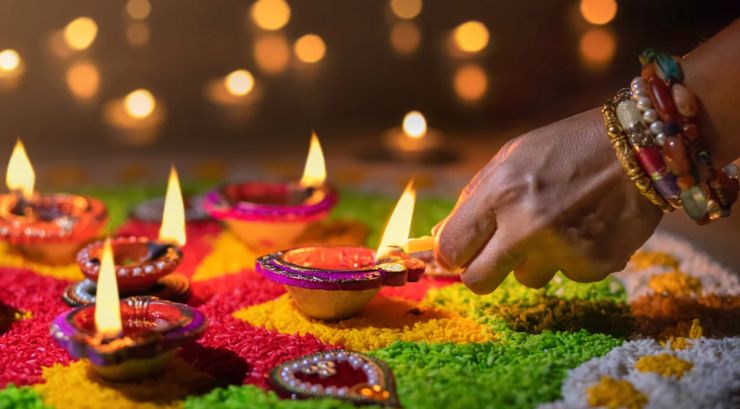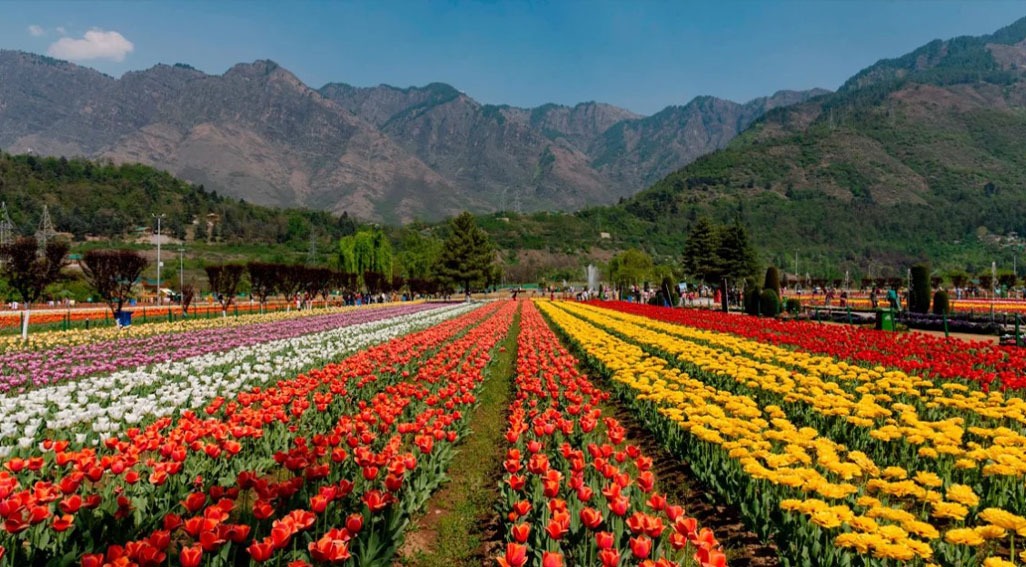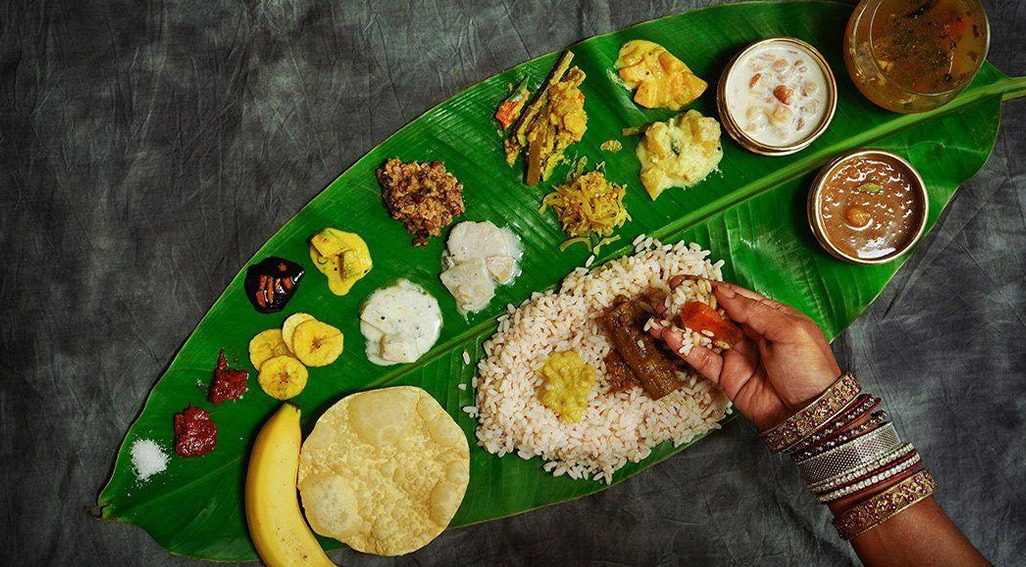Welcome to our savory sanctuary, where we invite you to indulge in culinary journeys through India— a land where every dish tells a story, and every meal is an experience. Thank you for subscribing to our newsletter and letting us share our love of India, food and travel with you.
‘Sadya’ is a grand vegetarian feast from Kerala, served on a banana leaf during festivals and special occasions like weddings. A typical Sadya consists of a 20 to 24 dishes, although it can include over 64 items in larger celebrations. It is eaten with the right hand, without cutlery, and people sit cross-legged on mats. Traditionally the banana leaf is placed with the tapering end pointing to the left of the guest. Folding the banana leaf towards oneself indicates satisfaction with the meal, while folding it away suggests room for improvement.
Our next culinary tour is planned for October. Hosted by Chand Sahrawat, we are excited to experience the magic of Diwali in a Palace in Udaipur. There are only two more spots available, so if you are keen, contact us now. Or if you want to experience the serenity of the Himalayas followed by the spirituality of Varanasi, then join our yoga and meditation retreat led by Susan Allen in September.
DESTINATION OF THE MONTH
KOVALAM

Kovalam is a seaside town along Kerala’s coastline in South India, just 16 kilometers from Thiruvananthapuram (Trivandrum) . It is one of those rare places which seem to be vibrant and tranquil at the same time. The first thing that hits you is the salty breeze, mingling with the aroma of spices and grilled seafood. I remember my first morning stroll on the beach in Kovalam, where fishermen were hauling in their morning catch. I couldn’t understand their language, but they sounded pretty happy with their catch that morning.
For anyone passionate about food, and seafood in particular, Kovalam is a revelation. The local cuisine is a celebration of Kerala’s rich culinary traditions – think coconut-laced curries, tangy tamarind, and a generous helping of curry leaves. The Kerala fish fry that I had in one of the beach shacks still makes me salivate.
Spices are the soul of every dish here. Pepper, cardamom,and cloves – once the currency of ancient spice traders, still dominate the flavours. No visit is complete without sampling a traditional Kerala Sadya, a vegetarian feast served on a banana leaf, with up to 20 dishes showcasing a harmony of textures and tastes.
The ideal day spent in Kovalam is a morning stroll on the beach, a hearty South Indian breakfast, followed by a 2-3 hour Ayurveda treatment to rejuvenate the body and mind. Enjoy a Sadya for lunch and then chill out by the pool. Make sure you don’t plan anything in the evening, as the sunsets over the ocean are spectacular, and you don’t want to miss those… The picture above is of Leela Kovalam, the only cliff top luxury 5-star resort in Kovalam, and our preferred hotel whenever we are in Kovalam.
THE SWICY REVOLUTION

India’s food scene in 2025 is all about bold innovations and creative mashups. That’s thanks to the “swicy” revolution, a fusion of sweet and spicy. This trend is being hailed by leading chefs as the defining flavor profile of the year. It’s both familiar and totally new and is taking over menus across the country.
To be honest, sweet and spicy food combinations aren’t new. They exist across numerous cuisines, especially in Southeast Asia from Thai sweet chili sauce to the Korean gochujang paste. But as the younger generation is ever so keen to experiment with bold flavours, the Swicy menu items are seeping into mainstream restaurants across India.
What’s driving this trend even further is that the chefs are having a field day, experimenting with everything from sweet chili chutneys to spicy-sweet street snacks, and even desserts with a fiery twist. Social media is buzzing with these colorful, mouthwatering creations, and people can’t get enough. It only takes one Instagram post or a Tweet from a famous cricketer or a Bollywood star to get attention from millions.
But swicy isn’t just about cranking up the heat, it’s about finding that perfect balance where sweetness and spice taste amazing together. As global fusion continues to influence Indian cuisine, swicy flavors are being integrated into both traditional and modern dishes. Some of the swicy treats doing the rounds are: Dark chocolate with a hint of chili; Mango salsa with a kick of jalapeño, Honey infused with chili, Swicy ice creams and even a Chili-Mango lassi.
Top 10 packing hacks
1. Roll, Don’t Fold: Rolling clothes instead of folding them saves space and helps prevent wrinkles. This is great for T-shirts, jeans, and casual wear.
2. Use Packing Cubes: Packing cubes help organize by category (e.g. tops, underwear, electronics) and make it easy to unpack at your destination.
3. Stuff Shoes with Socks or Accessories: Use the space inside your shoes to store socks, belts, or chargers. It maximizes space and helps shoes retain shape.
4. Protect Shoes With Shower Caps: Wrap the soles of your shoes in shower caps to keep dirt away from your clothes and maintain hygiene inside your suitcase

5. Dryer Sheets for Freshness: Tuck a dryer sheet into your suitcase to keep clothes smelling fresh, especially helpful if you’re traveling long-term or to humid areas.
6. Wear Bulky Items: Wear your heaviest or bulkiest items (like boots or jackets) on the plane to save space in your luggage.
7. Ziplock Bags for Electronics: Use small ziplock bags for cables, chargers, and adapters—one bag per type or device. Label them for easy access.
8. Scan or Photograph Important Documents: Digitally back up your passport, ID, tickets, and booking confirmations. Store copies on your phone in case originals are lost or stolen
9. Take a foldable bag: Always pack a lightweight, foldable tote bag—it’s handy for day trips, shopping, or separating dirty laundry.
10. Keep a Basic First Aid Kit: Take essential medications and a few basics like painkillers, plasters, and motion sickness tablets in your carry-on bag. It’s a small addition that can make a big difference if needed.
KASOORI METHI
Kasoori methi is dried fenugreek leaves. It is an essential herb in Indian cooking that brings a unique, slightly bitter, and aromatic depth to a variety of dishes. It originates from the Kasur region of Punjab (now in Pakistan), which lends the herb its name. In NZ it is available in all Indian specialty grocery stores.

This herb is also packed with nutrients and offers several health benefits:
- Aids digestion
- Supports heart health
- Regulates blood sugar
- Bossts immunity
- Promotes healthy skin and hair










